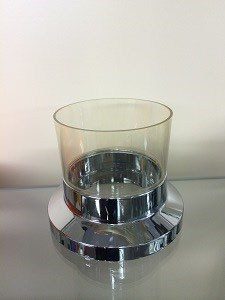After your part is developed and ready to go into the production phase, the size of the injection molding machine needs to be chosen.
 Determining the number of cavities in the mold is usually dictated by part cost and production time requirements. This will be explained in further detail in a future blog. For example, let’s say it has been determined that a four cavity mold is required. The part is a 6″ x 6″ by 3/16″ square. The first thing that must be calculated is the total projected shut-off area. This area consists of only the area that is 90° to the direction of the injection molding machine platens. With this mold, the calculation is 6″ x 6″ = 36 square inches x 4 cavities = 144 square inches of projected area. We only need to calculate the projected area , so the thickness has no bearing on the clamp tonnage. The rule of thumb is to have 2 to 5 ton of clamp tonnage per square inch of projected area. I usually use a minimum of 3 ton per square inch of projected area for standard parts and 5 ton for thin parts. With that being said, the 144 square inches of projected area requires a machine size of 432 ton which would move it up to a standard 500 ton machine. There are injection molding shops all over that have no choice but to try injection molding parts in undersized machines. In some instances, this can be accomplished when using a heavily filled material, since this material does not flash easy, less clamp tonnage is needed. For the most part, trying to injection mold a part in an undersized machine causes problems with the part quality due to the reduced pressure and speed caused by flashing the part. In the injection molding industry as well as most industries, the cost per hour goes up as the machine size increases.
Determining the number of cavities in the mold is usually dictated by part cost and production time requirements. This will be explained in further detail in a future blog. For example, let’s say it has been determined that a four cavity mold is required. The part is a 6″ x 6″ by 3/16″ square. The first thing that must be calculated is the total projected shut-off area. This area consists of only the area that is 90° to the direction of the injection molding machine platens. With this mold, the calculation is 6″ x 6″ = 36 square inches x 4 cavities = 144 square inches of projected area. We only need to calculate the projected area , so the thickness has no bearing on the clamp tonnage. The rule of thumb is to have 2 to 5 ton of clamp tonnage per square inch of projected area. I usually use a minimum of 3 ton per square inch of projected area for standard parts and 5 ton for thin parts. With that being said, the 144 square inches of projected area requires a machine size of 432 ton which would move it up to a standard 500 ton machine. There are injection molding shops all over that have no choice but to try injection molding parts in undersized machines. In some instances, this can be accomplished when using a heavily filled material, since this material does not flash easy, less clamp tonnage is needed. For the most part, trying to injection mold a part in an undersized machine causes problems with the part quality due to the reduced pressure and speed caused by flashing the part. In the injection molding industry as well as most industries, the cost per hour goes up as the machine size increases.
Another factor in choosing the right machine size is the shot size. On some engineered materials, the increased residence of the material in the barrel can often cause the material to degrade which causes poor part quality and also causes safety issues.
Some molds produce parts that could be produced in smaller sized machines but the size of the mold prevents it from fitting in a smaller machine due to added cam action slides and core pulls among other items.

Excellent post for us newbies trying to figure the right size machine / molds / etc. Thanks!
Thanks for the response and good luck.